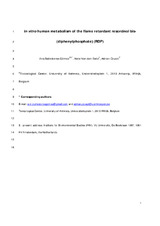In Vitro Human Metabolism of the Flame Retardant Resorcinol Bis(diphenylphosphate) (RDP)
Autor
Ballesteros-Gómez, A.
Van den Eede, Nele
Covaci, A.
Editor
ACSFecha
2015Materia
Resorcinol bis-(diphenylphosphate)Human liver microsomes
Metabolism
In vitro
Mass spectrometry
METS:
Mostrar el registro METSPREMIS:
Mostrar el registro PREMISMetadatos
Mostrar el registro completo del ítemResumen
Resorcinol bis(diphenylphosphate) (RDP) is widely used as a flame retardant in electrical/electronic products and constitutes a suitable alternative to decabrominated diphenyl ether. Due to its toxicity and its recently reported ubiquity in electronics and house dust, there are increasing concerns about human exposure to this emerging contaminant. With the aim of identifying human-specific biomarkers, the in vitro metabolism of RDP and its oligomers was investigated using human liver microsomes and human liver cytosol. Mono- and dihydroxy-metabolites, together with glucuronidated and sulfated metabolites, were detected. Regarding RDP oligomers, only a hydroxy-metabolite of the dimer could be detected. RDP and its oligomers were also readily hydrolyzed, giving rise to a variety of compounds, such as diphenyl phosphate, para-hydroxy-triphenyl phosphate, and para-hydroxy RDP, which were further metabolized. These degradation products or impurities are possibly of environmental importance in future studies.

